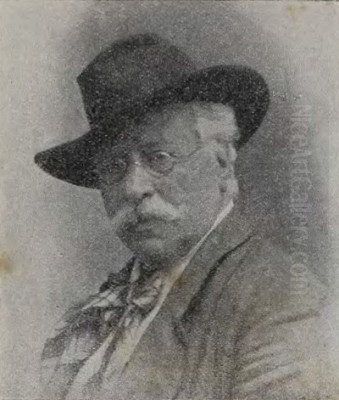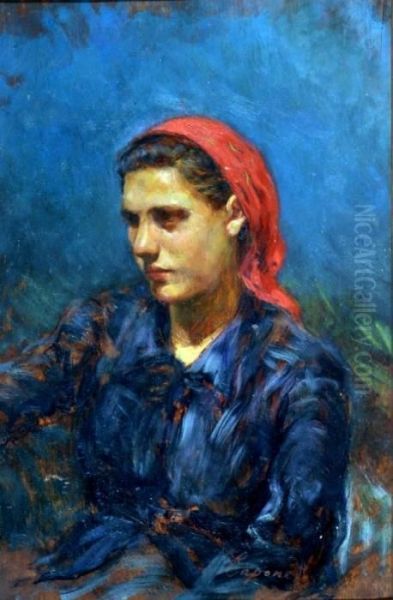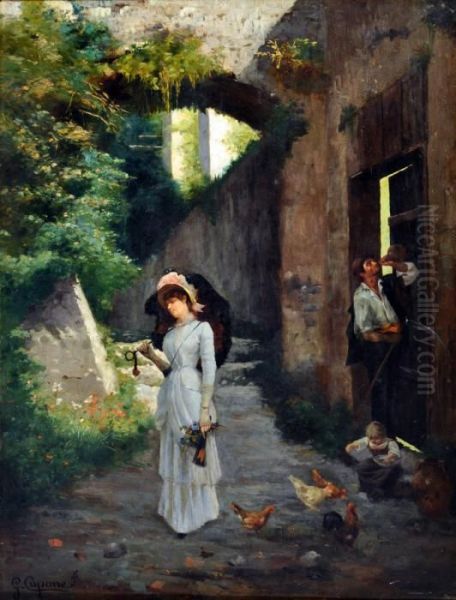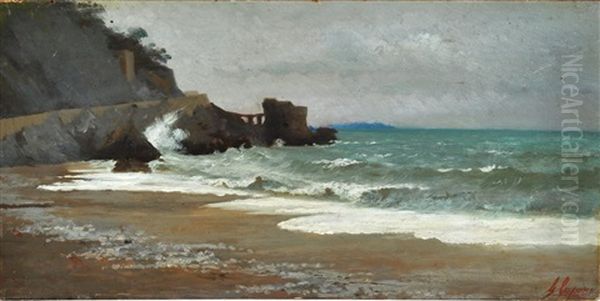
The late nineteenth and early twentieth centuries in Italy were a period of profound artistic effervescence, a time when regional schools flourished, each contributing its unique voice to the rich chorus of Italian art. Among these, the painters of the Amalfi Coast, particularly those associated with Maiori, carved out a distinctive niche, capturing the luminous beauty and everyday life of this enchanting region. Gaetano Capone (1845-1924) stands as a significant figure within this artistic milieu, an Italian painter whose works continue to be appreciated for their delicate execution, elegant use of color, and heartfelt depiction of his native landscapes and people.
The Artistic Landscape of Post-Unification Italy
To fully appreciate Gaetano Capone's contributions, it is essential to understand the broader artistic context of Italy during his lifetime. The latter half of the 19th century, following the Risorgimento and the unification of Italy, was a period of national identity formation, which also resonated within the arts. While a national artistic language was sought, regional traditions remained strong, with cities like Naples, Florence, Venice, and Milan fostering distinct artistic movements and schools.
Naples, in particular, had a long and storied artistic heritage. The Royal Academy of Fine Arts in Naples (Reale Accademia di Belle Arti di Napoli) was a pivotal institution, training generations of artists. The Neapolitan School of painting, known for its vibrant realism and dramatic use of light and shadow, had figures like Domenico Morelli and Filippo Palizzi who were influential. Morelli, with his historical and romantic subjects, and Palizzi, celebrated for his animal paintings and genre scenes imbued with a sense of naturalism, shaped the artistic environment from which many southern Italian painters emerged. The influence of Realism, and later, the stirrings of Impressionism and other modern movements, began to permeate Italian art, encouraging painters to look to their immediate surroundings for inspiration.
Maiori and the Allure of the Amalfi Coast

The Amalfi Coast, with its dramatic cliffs, azure waters, picturesque villages, and unique Mediterranean light, has long been a magnet for artists. Maiori, one of the larger towns along this coastline, became a notable center for a group of painters who, while perhaps not forming a "school" in the formal academic sense, shared a common inspiration and often a similar stylistic approach. These artists, often referred to as the "Maiori Painters" or "Costaioli" (painters of the coast), dedicated themselves to capturing the diverse facets of their environment.
This artistic flourishing was part of a broader European trend where artists sought out picturesque locales, often forming colonies or groups to share ideas and support. The rugged beauty of the Amalfi Coast offered an inexhaustible supply of subjects, from sweeping seascapes and sun-drenched beaches to intimate village scenes and portraits of local inhabitants. The clarity of the light and the intensity of the colors presented both a challenge and an inspiration, leading to works that often emphasized atmosphere and sensory experience.
Gaetano Capone: Life and Artistic Dedication
Gaetano Capone was born in 1845, and his life spanned a transformative period in Italian art. While detailed biographical information about his early training remains somewhat elusive in widely accessible records, his association with Maiori and his body of work firmly place him within the tradition of southern Italian landscape and genre painting. He was an Italian national, and his artistic identity is inextricably linked to the Amalfi Coast.
His professional output primarily consisted of oil paintings, a medium that allowed for rich color and nuanced depictions of light. The themes he explored were characteristic of the Maiori painters: the natural splendor of the coastline, the daily rhythms of local life, and the figures who populated these scenes. His approach was marked by a refined sensibility, with an emphasis on delicate brushwork and an elegant, harmonious color palette. These qualities align with the broader trends in Italian painting of the late 19th and early 20th centuries, which often balanced academic traditions with a growing interest in plein air painting and capturing transient effects of light and atmosphere.
The Maiori School: A Collective of Coastal Chroniclers
Gaetano Capone was not an isolated figure but part of a vibrant community of artists working in and around Maiori. This group, though diverse in individual styles, shared a common dedication to depicting the Amalfi Coast. Understanding Capone's work necessitates acknowledging his contemporaries and the collective artistic spirit they fostered.

Among the notable painters associated with the Maiori artistic environment were Raffaele D’Amato, known for his evocative coastal scenes. Pietro Scoppetta was another significant artist whose work often captured the lively atmosphere of Neapolitan and coastal life. Antonio Ferrigno, who also spent time in Brazil, brought a unique perspective to his depictions of the Amalfi Coast, often infusing them with a vibrant, almost exotic sensibility.
Angelo Della Mura contributed with his sensitive portrayals of the local landscape, while Luigi Paolillo is recognized for his ability to capture the distinctive light and color of the region. Luca Albino and Manfredi Nicoletti were also part of this artistic constellation, each adding their individual interpretations of the coastal scenery and its inhabitants. Together, these artists created a rich visual record of the Amalfi Coast, celebrating its beauty and preserving its cultural essence through their art. Their collective output demonstrates a shared commitment to realism, often tempered with romantic or impressionistic touches, reflecting the evolving artistic currents of the time. The presence of such a group would have undoubtedly created an environment of mutual influence and artistic dialogue, enriching the work of each member, including Gaetano Capone.
Artistic Style and Thematic Concerns in Capone's Work
Gaetano Capone's artistic style is characterized by its elegance, sensitivity, and keen observation of his surroundings. He excelled in both landscape and figure painting, often seamlessly integrating the two. His works typically convey a sense of tranquility and an appreciation for the simple beauties of nature and everyday life.
Landscape and Seascape: A significant portion of Capone's oeuvre is dedicated to the depiction of the Amalfi Coast. His seascapes capture the interplay of light on water, the dramatic forms of the cliffs, and the serene atmosphere of coastal mornings or late afternoons. Works like "Marina di Amalfi," which has appeared in auction records, attest to his skill in this genre. He would have been adept at rendering the subtle shifts in color and light that define the Mediterranean environment, from the brilliant blues of the sea and sky to the warm ochres and greens of the coastal vegetation.

Genre Scenes and Figurative Work: Capone also demonstrated a talent for genre scenes, depicting local people in their daily activities. These works offer a glimpse into the life of the Amalfi Coast during his time, capturing moments of work, leisure, and social interaction. His figures are often rendered with a gentle naturalism, conveying a sense of dignity and quiet presence. The "delicate brushwork" noted in descriptions of his style would have lent itself well to capturing the textures of clothing, the nuances of facial expressions, and the subtle gestures of his subjects.
Color and Light: An "elegant color palette" is a hallmark of Capone's style. This suggests a sophisticated understanding of color harmony and an ability to use color to evoke mood and atmosphere. Like many artists drawn to the Mediterranean, Capone would have been fascinated by the unique quality of light in the region – its clarity, intensity, and the way it transforms colors and shapes. His paintings likely reflect this fascination, with light playing a crucial role in defining form, creating depth, and imbuing his scenes with a luminous quality.
Representative Works: "Contadinella" and "Passeggiata"
Among Gaetano Capone's known works, "Contadinella" and "Passeggiata" are specifically mentioned as representative pieces, both executed in oil and bearing the artist's signature.
"Contadinella": This title translates to "country girl" or "little peasant girl." The painting, measuring 53x24 cm, suggests an intimate portrait or a focused genre scene. The subject matter aligns with a popular theme in 19th-century European art: the depiction of rural life and peasant figures. Artists were often drawn to these subjects for their perceived authenticity, simplicity, and connection to the land. Capone's "Contadinella" likely portrays a young woman from the Amalfi region, perhaps engaged in a typical activity or simply posing for the artist. Given his characteristic style, the work would probably be rendered with sensitivity, capturing the girl's character and the textures of her attire with delicate brushwork and a harmonious use of color. The relatively small, vertical format might suggest a focus on the figure itself, perhaps in a characteristic pose or setting that speaks to her way of life.
"Passeggiata": This work, larger in size at 117x89 cm, translates to "a walk" or "a stroll." The title evokes a scene of leisure, perhaps figures enjoying a promenade along the coast or through a village. The painting is dated 1924, placing it very late in Capone's career, indeed the year of his death. This suggests it could represent a culmination of his artistic concerns or a reflection on a lifetime spent observing and depicting the life around him. The larger dimensions would have allowed for a more expansive composition, potentially including multiple figures, a detailed landscape or architectural setting, and a more complex interplay of light and shadow. A "passeggiata" is a quintessential Italian social ritual, and Capone's depiction might capture the elegance and social dynamics of such an outing, set against the picturesque backdrop of the Amalfi Coast.
These two works, though different in scale and likely focus, exemplify Capone's engagement with the people and places of his native region. They showcase his commitment to oil painting and his practice of signing his works, a standard affirmation of authorship.
Influences and Artistic Affinities
Gaetano Capone's art was shaped by various influences, both local and broader. His primary artistic environment was undoubtedly the Maiori school, where he shared thematic and stylistic concerns with artists like D’Amato, Scoppetta, and Ferrigno. The collective energy of this group, their shared focus on the Amalfi Coast, and the likely exchange of ideas would have been a formative influence.
Beyond his immediate peers, the provided information suggests a possible connection to the style of Bartolomeo Pedon (1665-1732), a Venetian painter active much earlier. Pedon was known for his landscapes, often with a romantic or pre-Romantic sensibility, and for his skill in still life. If Capone did indeed draw inspiration from Pedon, it might have been in Pedon's treatment of light, his atmospheric effects, or a certain freedom in depicting nature that resonated with Capone's own artistic inclinations. While separated by nearly two centuries, the enduring appeal of Italian landscape traditions could bridge such a temporal gap, with later artists looking to earlier masters for inspiration in capturing the essence of the Italian scene.
Furthermore, the broader currents of Italian art in the late 19th century would have played a role. The legacy of the Macchiaioli, a group of Tuscan painters who, from the 1850s, advocated for painting outdoors and using "macchie" (patches or spots) of color to capture light and form, had a lasting impact on Italian landscape painting. Artists like Telemaco Signorini, a prominent Macchiaiolo, championed a truthful depiction of reality. While Capone's style is described as more "delicate" and "elegant," the Macchiaioli's emphasis on direct observation of nature and light was part of the artistic air he breathed.
The Neapolitan tradition, with figures like Giuseppe De Nittis, who achieved international fame and had connections with French Impressionism, also contributed to the richness of Italian art during this period. De Nittis, though from Barletta, was trained in Naples and his sophisticated depictions of modern life and atmospheric landscapes showcased an international sensibility. Even the society portraiture of an artist like Giovanni Boldini, with his dazzling brushwork, while different in subject, was part of the vibrant Italian art scene that valued technical skill and elegance. These artists, along with others like Francesco Paolo Michetti, known for his powerful depictions of Abruzzese life and landscapes, and Antonio Mancini, with his thickly impastoed portraits, demonstrate the diversity and dynamism of Italian painting during Capone's active years. While direct influence from all these figures on Capone is not explicitly stated, they formed the artistic tapestry of his time, contributing to a climate where regional schools like Maiori could thrive.
Exhibitions, Recognition, and Art Historical Evaluation
Gaetano Capone's work received recognition during his lifetime and continues to be valued. His paintings have been featured in exhibitions, indicating an appreciation for his artistic merit. One such exhibition was "SMALL Wonders, Piccole Meraviglie," held in Florence. This international exhibition, which included artists from numerous countries, suggests that Capone's work was considered of a quality to be shown alongside a diverse range of contemporary art.
More specific to his regional focus, Capone's paintings were exhibited in an "ideal" gallery on the Amalfi Coast dedicated to showcasing the Maiorini painters. Such a gallery would have played a crucial role in promoting the work of local artists, fostering a sense of collective identity, and making their art accessible to both local patrons and the increasing number of tourists drawn to the region's beauty. The existence of such a venue underscores the significance of the Maiori artistic group and Capone's place within it.
In the contemporary art market, Gaetano Capone's paintings appear in auctions, and their sale prices reflect a continued appreciation for his skill and the appeal of his subjects. This market presence is an important indicator of an artist's enduring legacy and the value placed on their work by collectors and art enthusiasts.
Art historical evaluation places Gaetano Capone as a notable representative of the Maiori school and a skilled practitioner of late 19th and early 20th-century Italian landscape and genre painting. His work is praised for its "fine brushwork and elegant use of color," qualities that appeal to a sensibility that values technical refinement and aesthetic harmony. While his fame may be more localized compared to some of the leading national figures of his time, his contribution to the artistic heritage of the Amalfi Coast is undeniable. He, along with his Maiori colleagues, helped to define a visual identity for this celebrated region, capturing its unique charm and character for posterity.
It is important, as noted in some contexts, to distinguish Gaetano Capone the painter from other individuals who may share the same name but are known for entirely different fields of activity, such as the infamous Al Capone or other academic or professional figures. Focusing clearly on Gaetano Capone (1845-1924), the Italian painter, ensures that his specific artistic contributions are accurately recognized and appreciated.
The Enduring Appeal of Capone's Vision
The art of Gaetano Capone continues to resonate today due to several factors. His depictions of the Amalfi Coast tap into the enduring allure of this world-renowned landscape. For those familiar with the region, his paintings evoke a sense of nostalgia and recognition. For those who know it only by reputation, his works offer a captivating glimpse into its timeless beauty.
His focus on everyday life and local figures also contributes to the appeal of his art. These genre scenes provide a human connection, offering insights into the culture and traditions of the Amalfi Coast in a bygone era. In a world that is rapidly changing, such depictions of simpler times and close-knit communities hold a particular charm.
Furthermore, the aesthetic qualities of Capone's work – his delicate technique, harmonious colors, and sensitive rendering of light – possess a timeless appeal. His paintings are not overtly challenging or radical in the modernist sense; rather, they offer a vision of beauty, tranquility, and refined craftsmanship. This makes his art accessible and enjoyable to a broad audience.
Conclusion: Gaetano Capone's Legacy
Gaetano Capone (1845-1924) was a dedicated and skilled Italian painter who made a significant contribution to the artistic representation of the Amalfi Coast. As a key figure associated with the Maiori painters, he meticulously chronicled the landscapes, seascapes, and daily life of his beloved region. His works, such as "Contadinella" and "Passeggiata," exemplify his refined style, characterized by delicate brushwork, an elegant color palette, and a profound sensitivity to light and atmosphere.
Situated within the rich artistic context of late 19th and early 20th-century Italy, Capone's art reflects both the enduring traditions of Italian painting and the specific charms of his local environment. He worked alongside a community of artists in Maiori, including Raffaele D’Amato, Pietro Scoppetta, and Antonio Ferrigno, who collectively forged a distinct artistic identity for the Amalfi Coast. While possibly drawing inspiration from earlier masters like Bartolomeo Pedon and working within a national artistic scene that included luminaries such as Domenico Morelli, Filippo Palizzi, and Giuseppe De Nittis, Capone maintained a personal vision rooted in his immediate surroundings.
His participation in exhibitions and the continued presence of his works in the art market attest to the lasting appreciation for his talent. Gaetano Capone's legacy lies in his beautiful and heartfelt depictions of a unique corner of Italy, preserving its essence in oil and canvas for future generations to admire. He remains an important figure for understanding the regional artistic expressions that flourished in Italy and contributed to the nation's rich cultural tapestry.